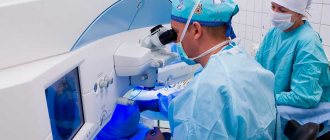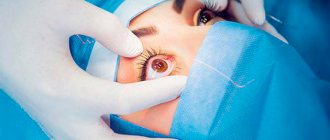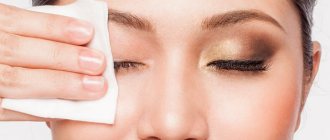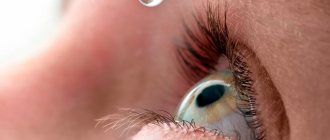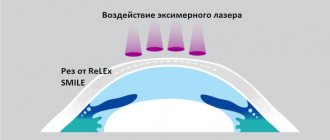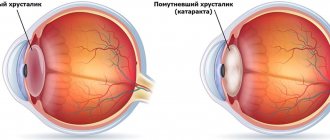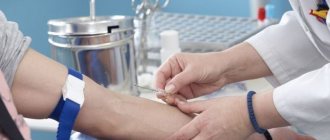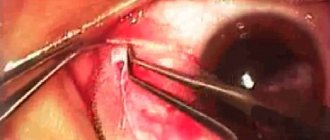Causes Symptoms Video of surgery Treatment Why choose us Prices
Chalazion is a common eye disease or chronic inflammation caused by a blockage in the fatty (meibomian) gland of the eyelid. The name chalazion is translated from Greek as a nodule or hailstone. Indeed, in a patient with a chalazion, a small, round, dense formation can be felt in the area of the upper or lower eyelid. The disease is more often detected in patients aged 20 - 50 years, children get sick less often.
Causes
Meibomian glands are located in the thickness of the upper and lower eyelids, their excretory ducts open at the eyelash line, near the posterior edge of the eyelids. Normally, the glands secrete a fatty secretion that moisturizes and lubricates the edges of the eyelids, reducing friction on the surface of the cornea. The triggering point for the formation of a chalazion is a blockage of the meibomian gland duct. The cause of blockage may be infection (due to dysbacteriosis, weakened immunity), dirty hands, violation of the rules of wearing contact lenses, increased oily skin. In some cases, a chalazion forms secondarily, at the site of an acute inflammation of the eyelid that has not been fully treated (stye).
Other causes of blockage of the meibomian glands include:
- anatomical features of the meibomian gland ducts (too narrow, tortuous);
- thickening of the secretion of the gland, as a result of which its removal becomes difficult;
- diseases of the endocrine system and metabolic disorders (diabetes mellitus, obesity, etc.);
- frequent or chronic inflammatory eye diseases (conjunctivitis, blepharitis, etc.);
- cicatricial changes in the tissues of the eyelids, for example, with frequent or multiple styes;
- dermatological diseases accompanied by a violation of the cell division cycle, excessive or insufficient activity of the sebaceous glands (rosacea, seborrheic dermatitis, etc.);
- chronic diseases of the digestive system.
When a chalazion forms, there is often a combination of several factors. For example, using a large amount of decorative cosmetics or wearing false eyelashes together with metabolic disorders or disorders of the immune system.
In situations where blockage of the meibomian gland is observed in a chronic course, it is important to establish the causes and prerequisites and eliminate them.
Symptoms
The blocked meibomian gland increases in size and is surrounded by a dense capsule.
At the initial stage of development of the disease, such compaction is externally invisible and can only be felt (when washing off makeup, touching the eyelids, etc.).
But as the secretion accumulates more and more in the capsule, the formation increases in size and becomes more noticeable.
Along with this, itching in the eye, watery eyes, and a general feeling of discomfort may appear, depending on what part of the eyelid the chalazion is located. Severe swelling and redness of the eyelid in the case of an uncomplicated course of the disease is usually absent, vision is not impaired. The quality of vision may suffer in cases where the chalazion reaches large sizes (sometimes up to 1 cm in diameter) and because of this “blocks” part of the field of vision, causing severe discomfort when blinking.
With prolonged absence of treatment, growth of the tumor is not the only threat. The lack of secretion outflow from the gland becomes a predisposing factor for infectious complications. When a secondary infection occurs, symptoms of inflammation come to the fore: redness of the mucous membrane of the eyelid, swelling of the eyelid and hyperemia of the skin in the chalazion area, pain.
In some cases, the chalazion opens spontaneously, but in most cases the disease is chronic. In this case, the patient needs to be examined by a specialist and prescribed adequate treatment.
Particular attention should be paid to patients over the age of 40 who have discovered a similar formation on their eyelid. You should not put off going to the doctor, despite the fact that the disease does not disrupt your usual way of life. In older people, in rare cases, a meibomian gland tumor is detected, including a malignant one, the symptoms of which in the early stages do not differ in any way from the symptoms of a chalazion.
How long does it take for a wound to heal?
The duration of the rehabilitation period is 12-24 hours. Most often, unpleasant consequences disappear on the day of the operation. The patient can return to work and normal lifestyle the next morning.
How long a chalazion will heal after laser surgery depends on the individual characteristics of the body, on average - from 7 to 10 days.
After the surgeon completes his work, the intervention area may swell. The swelling should gradually subside over the next few hours. Complications in the form of hematomas and bruises are practically excluded. The doctor does not apply mechanical influence.
To reduce the risk of complications during the recovery period after removal, it is recommended:
- do not wash the operated eye for the next 7-10 days;
- do not touch with your hands or rub to prevent infection;
- On the 10th day after surgery, go to the doctor for a follow-up examination.
If access was made from the mucous membrane, the patient is advised to wear a soft lens for 4-5 days. It protects the wound from contact with the cornea and prevents pain and discomfort during blinking.
According to the doctor's decision, corticosteroid hormones may be prescribed to help the wound heal faster and not become inflamed.
Additionally, antibacterial drops and ointments may be prescribed.
Diagnostics
Before prescribing treatment, the doctor interviews the patient, collects anamnesis, and conducts an examination. To confirm the diagnosis, an external examination is often sufficient, which consists of everting the eyelid and assessing all the parameters of the neoplasm (redness and swelling, whether or not extending beyond the chalazion, the absence or presence of signs of an infectious process, etc.).
In cases where the doctor has doubts about the nature of the disease, a histological examination is performed. It allows you to exclude or confirm the malignant nature of the neoplasm. During the diagnosis, the characteristics of the course of the chalazion are also determined, which plays a role in prescribing treatment.
Useful video
Chalazion therapy is a complex and difficult process. The laser removal method is not only effective, but also safe; the laser will help remove the purulent capsule in 15 minutes without any consequences for the patient.
Author's rating
Author of the article
Alexandrova O.M.
Articles written
2031
about the author
Was the article helpful?
Rate the material on a five-point scale!
( 2 ratings, average: 5.00 out of 5)
If you have any questions or want to share your opinion or experience, write a comment below.
Types of chalazion
Blockage of the meibomian gland ducts can be chronic and abscessive.
Chronic chalazion . The formation of a chalazion occurs over a long period of time and gradually. There are no periods of exacerbation, no signs of inflammation.
Abscess chalazion . This course of the disease is observed when an infectious agent penetrates the capsule. At the same time, the clinical manifestations of chalazion become more pronounced. The patient complains of pain in the area of the tumor or the entire eyelid, swelling, itching, pain in the eyes.
Chalazion treatment
Self-treatment of chalazion at home before a doctor examines the affected eye and makes a final diagnosis is not recommended. It is forbidden to try to squeeze or pierce the chalazion yourself; this can have very serious negative consequences.
Depending on the duration of the disease and the characteristics of the process, conservative or surgical treatment methods are used.
Drug treatment is effective only at the very beginning of the disease, and delaying contacting a doctor is a way to wait until the need for surgical treatment of chalazion.
Fresh, uncomplicated chalazion responds quite well to conservative treatment with anti-inflammatory eye drops and ointments (hydrocortisone, 1% yellow mercury). In the absence of symptoms of inflammation, the doctor may additionally prescribe dry heat (UHF) and eyelid massage. In the event of a secondary infection, any thermal procedures (compresses, warming) are contraindicated, because this contributes to the spread of inflammation to adjacent tissues with the subsequent development of limited (abscess) or diffuse (phlegmon) inflammation of the eyelid.
Another effective method of treating chalazion is injection of anti-inflammatory drugs into its cavity (Kenalog, Diprospan, etc.). The drug selected by the doctor is injected directly into the chalazion cavity, this promotes the gradual resorption of the pathological formation over 1-2 weeks.
Along with drug and physiotherapeutic treatment, it is important that the patient strictly observes the rules of personal hygiene and eliminates factors that contribute to re-occlusion of the meibomian gland (long-term wearing of unsuitable contact lenses, use of decorative cosmetics, etc.).
It is important to understand that self-medication is unacceptable, since the visual organs are very vulnerable to any intervention. And attempts to get rid of a chalazion on your own can lead to eye injury, decreased visual acuity and other serious consequences.
What to do if the chalazion has ruptured?
If a cyst spontaneously ruptures, you should not panic and rush to your doctor. First of all, treat the sore eye with an antibacterial agent. Chlorhexidine is suitable for this. Then use any antiseptic.
What to do next? The pus may not completely flow out of the ruptured seal, which is dangerous due to subsequent complications. As soon as the wound has been disinfected, you should immediately go to a specialist. Further actions will be aimed at removing the remaining pus and accumulated secretions from the duct.
The doctor will surgically clean the pouch of excess residue. Next, treatment will be prescribed.
Therapy is prescribed individually to each patient depending on his general condition at the time of diagnosis.
Antimicrobial drugs are prescribed as medications, which need to be used to regularly treat the eyelid.
If it is not possible to visit your doctor, then you need to start treatment yourself, using pharmacological agents and traditional methods. As a compress, apply Levomekol ointment or a cut aloe leaf to the rupture site. You need to keep the compress for an hour. The procedure should be repeated daily until the inflammation and pus are completely removed.
You may be interested in: How to quickly and effectively treat lower eyelid chalazion?
Removal operation
Neoplasms 5 mm in size, long-existing or prone to recurrence must be removed surgically. The operation is usually performed on an outpatient basis, under local anesthesia, and its duration does not exceed 20–30 minutes. The doctor grabs the area of the eyelid with the chalazion using a fenestrated clamp, then opens the neoplasm and removes it along with the capsule. If there is a fistula tract, it is opened and excised along its entire length. After several stitches are placed, a pressure bandage is applied to the area of the operated eye. For a week after surgery, you will need to instill anti-inflammatory drops or apply ointment.
Features of the rehabilitation period
After the intervention, special care is required for the operated eye. The aseptic bandage must be worn for 3-5 days; it can be removed only when drops are instilled into the eye or ointment prescribed by the ophthalmologist. It is necessary to avoid getting water into the eye, and also do not scratch or rub it. The recovery period lasts an average of a week, after which the patient can return to normal life. Don’t risk your eye health and your vision - call or make an appointment online for a consultation with an ophthalmologist at GMS Hospital and learn more about chalazion and its treatment methods.
Laser chalazion removal
Chalazion removal surgery can also be performed using a medical laser. This method has its advantages:
- Less traumatic intervention. A surgical laser provides high precision tumor removal without affecting healthy tissue.
- Higher safety profile. This is also due to the high-precision impact on the chalazion: the risks of damage to the tissues surrounding the formation are eliminated.
- Reducing the risk of complications. When the laser comes into contact with tissue, immediate coagulation of blood vessels occurs, which avoids bleeding during or after surgery. And exposure to high temperatures, although it occurs within a fraction of a second as part of a single action by the surgeon, ensures tissue disinfection and eliminates the possibility of infection.
The choice of a specific method of surgical removal, necessary and appropriate in a particular case, remains with the attending physician.
Features of hailstone removal in children
Chalazion removal in children is the same as in adults. The only difference is the possibility of administering general anesthesia. Most often, general anesthesia is used for small children who cannot remain motionless for a long time. For children, doctors try to remove hailstones with a laser to avoid the need for stitches, since there is a high risk of injury as a result of rubbing the eye with threads.
After surgery, children often experience relapses of the pathology.
It is very important that the child maintains eye hygiene during the recovery period, constantly wears a bandage and strengthens the immune system.
Indications for surgical removal of chalazion
Chalazion removal is indicated under the following circumstances:
- Conservative treatment was ineffective.
- the effect of conservative treatment is short-term.
- The size of the chalazion exceeds 5 mm in diameter.
- any complications (impaired vision quality, infection, etc.).
- frequent relapses of chalazion.
This list of indications for surgical removal of a chalazion can be expanded at the discretion of the attending physician.
Postoperative rehabilitation
After the operation, it is important to follow the recommendations for eye restoration; for this you need:
- do not expose the affected eye to the negative effects of water during the first few days of recovery, as there is a risk of infection of the wound;
- You should refrain from removing the crust formed on the wound yourself; you must wait until it disappears on its own;
- Do not touch the surgical site with your hands, much less scratch it;
- in the first couple of days you should not sit at the computer for a long time;
- To prevent discomfort, it is recommended to wear contact lenses prescribed by a doctor;
- After surgery, you cannot stay outside for a long time, since dust particles and pathogens can penetrate into the wound;
- You should not swim in open reservoirs and specialized pools.
It is recommended to strictly follow all prescribed recommendations to your attending physicians to prevent the development of complications.
Advantages of treatment of chalazion in MGK
Our doctors are ready to provide the necessary medical and diagnostic assistance every day, seven days a week, from 9 am to 9 pm. Attentive attitude, high-quality diagnostics using the best examples of modern technology, as well as the vast practical experience of our specialists are a guarantee of high treatment results even in the most complex cases. After the diagnosis, our specialists will explain the results in clear language and, if necessary, recommend possible treatment methods.
All medical procedures are carried out using sterile instruments in specially equipped operating rooms, in compliance with the rules of asepsis and antisepsis, which eliminates the possibility of infection.
Chalazion removal occurs on an outpatient basis, usually under local anesthesia. According to indications (childhood, low stress resistance), other methods of pain relief can be used. All removed tumors must undergo histological examination to exclude the possibility of a malignant tumor. We take responsibility for the results of treatment, so our specialists ensure regular examination of the patient after surgery until his full recovery. Our doctors will also recommend the best ways to strengthen your immune system to prevent recurrence of the disease.
Prevention of chalazion development
Since the development of chalazion is closely related to the level of personal hygiene, it is important to adhere to the following rules:
- Avoid eye contact with other people's personal items (towels, cosmetics, etc.);
- Rinse off decorative cosmetics thoroughly using special delicate products.
- Monitor the length of time you wear contact lenses and remove them on time.
- Carry out regular and proper antiseptic treatment of contact lenses.
- Train yourself not to touch your eyes unless absolutely necessary, and do this only after thoroughly washing your hands.
In addition, it is important to monitor your general health, since many diseases of internal organs and skin can provoke the development of chalazion.
Expert opinion
Experts in the field of ophthalmology are inclined to believe that the level of personal hygiene plays a decisive role in the formation of a chalazion. This means that, other things being equal, the disease is more likely to develop in those who neglect hygiene requirements.
Therefore, it is important to keep your facial skin clean, use specialized products when washing your face, accustom yourself to regularly wash your hands, and refuse to use other people’s personal items (cosmetics, towels, etc.)
FAQ
Chalazion is a fairly common disease. In this regard, patients often have the following questions:
Are styes and chalazions the same thing? No. Barley is an inflammation of the hair follicle (eyelash), and a chalazion develops in the thickness of the eyelid itself. In addition, barley has an acute course - it ripens within 3-4 days, after which it often opens spontaneously, releasing purulent contents. Chalazion progresses slowly, and suppuration is observed very rarely.
Can a stye turn into a chalazion? No, he can not. But the frequent appearance of styes may indicate health problems, which themselves can provoke blockage of the meibomian gland. In addition, frequent styes can cause microscopic scar changes in the tissues of the eyelids, and this becomes a prerequisite for blockage of the meibomian gland ducts.
Is the tendency to form chalazions inherited? No hereditary link has been identified, but some diseases of the endocrine system or other diseases that increase the likelihood of developing a chalazion can be passed on from parents to children. Familial cases of chalazion, which affects all or many members of the family, are more likely to be associated with hygiene habits (for example, lack of habit of washing hands before washing the face) rather than with genetic factors.
Can a new chalazion form in place of the removed one? This doesn't happen often, but it's still a possibility. To minimize such situations, it is important to identify the cause of chalazion formation, since many of them can be eliminated (for example, nutritional disorders, untreated diseases of the gastrointestinal tract, etc.).
Who is more likely to get chalazion? For those who are in one way or another predisposed to blockage of the meibomian gland ducts (anatomical features of the structure of the ducts, frequent inflammatory or infectious eye diseases, neglect of hygiene rules, etc.).
What to do if a chalazion appears? Contact your doctor. Although chalazion does not pose an immediate threat to health and life, it can cause infectious complications. In addition, in older people, a malignant neoplasm can be “masked” as a chalazion.
Chalazion treatment cost
The price of injection of the drug into the cavity of the upper or lower eyelid (Diprospan, Kenalog, etc.) in our clinic is only 1,000 rubles (1 injection). No analysis is required.
The cost of surgically removing a chalazion at the Moscow Eye Clinic is 9,500 rubles .
All questions you are interested in can be asked by phone (calls from mobile phones and regions of the Russian Federation are free) and by phone in Moscow or online using the appropriate form on the website.
Mironova Irina Sergeevna
Preparing for surgery
There is no specific preparation for laser surgery. The treatment is minimally invasive, considered safe and performed on an outpatient basis. But before the operation, it is expected to undergo the necessary tests: analysis for sexually transmitted diseases (HIV, HPV, syphilis, hepatitis), for this purpose a general urine test and a couple of blood tubes are taken to identify the above pathologies.
This stage before the operation helps doctors timely diagnose a dangerous disease and prevent its reproduction outside the patient’s blood, since if one of the sexually transmitted diseases is detected, the doctor will have to perform an operation on the patient, in whose blood there is the causative agent of the dangerous disease. An analysis is required to determine the level of blood clotting; in case of deviation, the patient is prescribed a different treatment regimen.
Before the operation, consultation with an ophthalmologist and ophthalmic surgeon is necessary, and a hardware examination of the visual organs is also prescribed.
During preparation, allergy tests for anesthesia are required; otherwise, the patient will not be allowed to undergo surgery.
